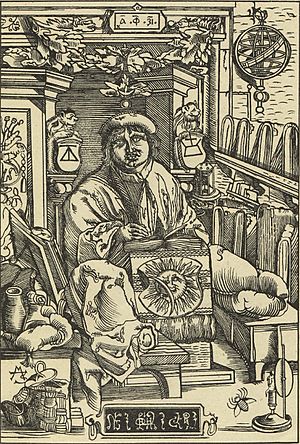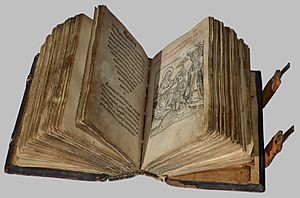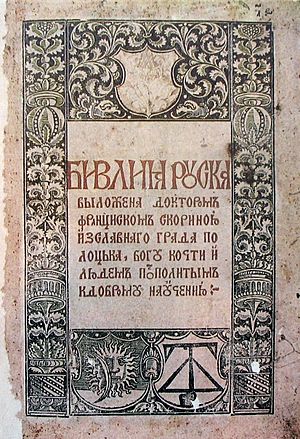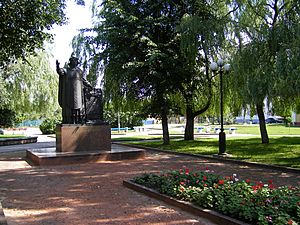Francysk Skaryna facts for kids
Quick facts for kids
Francysk Skaryna
|
|
|---|---|
 |
|
| Born |
Francišak Skaryna
1470 |
| Died | 1551/29 January 1552 (aged 81-82) |
| Occupation | humanist, physician, and translator |
| Known for | one of the first book printers in the Grand Duchy of Lithuania and in all of Eastern Europe |
Francysk Skaryna (born around 1470 – died 1551 or January 29, 1552) was an important figure from Belarus. He was a humanist, a doctor, and a translator. Skaryna is famous for being one of the very first people to print books in the Grand Duchy of Lithuania and in all of Eastern Europe. His work helped to develop the Church Slavonic language, especially its Belarusian version.
Contents
Early Life and Education
Francysk Skaryna was born in Polotsk, a busy trading city in the Grand Duchy of Lithuania. His family was wealthy; his father, Luka Skaryna, was a merchant. Francysk also had an older brother, Ivan, who was a merchant too. They owned property in Polotsk.
Most experts believe Skaryna was born in 1470. He started his studies at Jagiellonian University in Kraków in 1504. In 1506, he earned his first degree, a Bachelor of Arts. Later, in 1512, he went to the University of Padua in Italy. There, he passed all his exams and became a doctor of medicine. He had also earned another degree, an "artium doctor," but we don't know exactly when or where he got it.
Life as a Printer
Skaryna moved to Prague by 1517. In that same year, he rented a printing house and began publishing his own translations of the Bible. He also wrote his own introductions for these books.
On August 6, 1517, his first book, "The Psalter," was released. This book contains many parts of the Bible. Over the next few months, he released more books. By 1519, he had printed twenty-three books of the Bible. This was a huge achievement and a major part of his life's work.
In 1522, Skaryna opened the first printing house in Vilnius. There, he published "The Little Travel Book." In 1525, he published another important book called "Apostol." This book was arranged in the same way it is used in Orthodox church services today.
Skaryna tried to sell his books in Moscow in the late 1520s or early 1530s, but he was not successful there.
He married a woman named Margarita, who was a widow from Vilnius. After his brother Ivan died, Skaryna went to Poznań to get his share of Ivan's property. He and Margarita later moved to Königsberg for a short time before returning to Vilnius.
In 1532, Skaryna worked as a doctor and secretary for John, Bishop of Vilnius. However, he faced problems when his late brother's creditors had him put in prison in Poznań. He was there for several months. His nephew, Roman Skaryna, helped him by talking to King Sigismund I. After his release, Skaryna complained to the King. The King then gave him two special certificates. These certificates meant that only the King could judge him, protecting him from other authorities.
The last records of Skaryna are from 1534. He moved from Vilnius to Prague and likely worked in the royal garden until he died. He probably passed away between 1551 and January 29, 1552. In 1552, his son, Simeon Rus Skaryna, received all of his father's property, including his writings and books.
About His Religion
It is not fully known if Skaryna was Catholic or Orthodox. His name, Francysk, is Catholic. Some people thought he changed his name, but this idea is not widely accepted today.
In 1552, after Skaryna had died, King Sigismund August wrote a letter. He mentioned that a man from his country had printed a translation of the Bible and tried to sell it in Moscow. But the books were burned there because they were made "by a subject of the Roman Church." It is very likely that the King was talking about Skaryna's books.
Publishing Achievements
Skaryna dedicated his life to printing the Bible. He wanted to make the Bible easier for everyday people to read and understand. He wrote introductions for his books, explaining that his goal was to help people "become acquainted with wisdom and science." His work also helped develop the Belarusian literary language. His Bible was the second printed Bible in the Slavic world, after a Czech version.
Books Printed

Skaryna began printing in Prague in 1517. He printed his Psalter, and then twenty-two books of the Old Testament under the name Biblia Ruska. His books were different from other European Bibles of that time. They were all printed in a smaller, easy-to-handle size. Skaryna's Bibles were printed in the Church Slavonic language, but they included many words from the Ruthenian language. You can also see influences from Polish and Czech language in his writings.
Skaryna's books helped to shape the Belarusian version of the Church Slavonic language.
His Bible was unique because it included his own notes, introductions, and afterwords. It even had pictures of him inside, which was very unusual for Bibles in Eastern Europe at that time.
Today, all of Skaryna's printed books are very rare. Copies can be found in libraries in cities like Minsk, Moscow, St. Petersburg, Kyiv, Vilnius, London, and Prague.
Legacy and Impact
The language Skaryna used in his books was based on Church Slavonic, but it had many Belarusian words. This made his books easier to understand for people living in the Grand Duchy of Lithuania (which is now Belarus). Skaryna was one of the first to print books using the Cyrillic alphabet. However, he was not the very first; the Oktoikh was printed in 1491 by Schweipolt Fiol. Since there was no standard Belarusian language back then, it's hard to say exactly what language he used. Some experts believe his books were in Church Slavonic with a lot of Ruthenian words.
Some Belarusian scholars see Skaryna as a "Renaissance man," much like famous figures such as Copernicus. They believe his work in the Slavic lands was part of the European Reformation.
After the Soviet Union broke apart, the main street in Minsk, the capital of Belarus, was renamed Skaryna Avenue. However, in 2005, it was changed again to Independence Avenue. Another street in Minsk, the Old Barysau Way, was renamed Skaryna Street. Many other cities in Belarus, like Polotsk, Vitebsk, and Orsha, also have streets named after Francysk Skaryna.
Belarus gives two awards in Skaryna's honor: the Medal of Francysk Skaryna and the Order of Francysk Skaryna. There are statues of him in cities like Polotsk, Minsk, Lida, Vilnius, and Prague.
Several cultural groups are named after Skaryna, including the Frantsishak Skaryna Belarusian Language Society in Belarus and the Francis Skaryna Belarusian Library and Museum in London. Homyel State University is also named after him.
In 1969, a movie called "I, Francysk Skaryna" was made about his life. In 1991, Skaryna was even featured on a one-ruble coin in the Soviet Union.
See also
 In Spanish: Francysk Skaryna para niños
In Spanish: Francysk Skaryna para niños
- Symon Budny
- Ivan Fedorov
- Johann Gutenberg
- Spiridon Sobol
- Spread of the printing press



